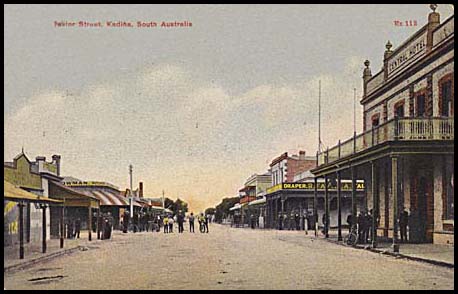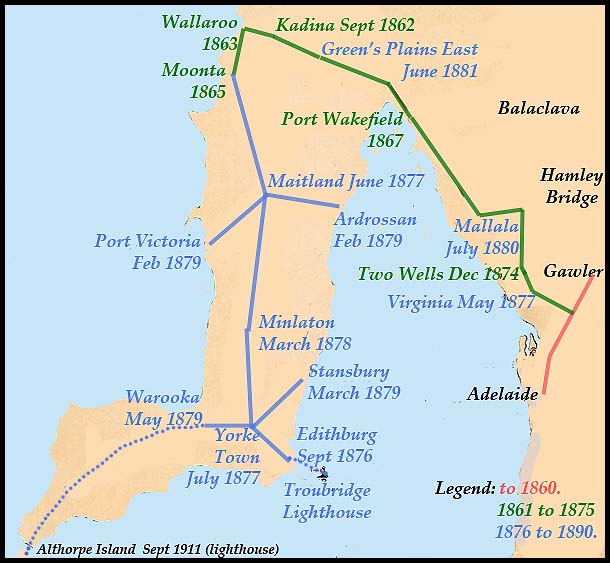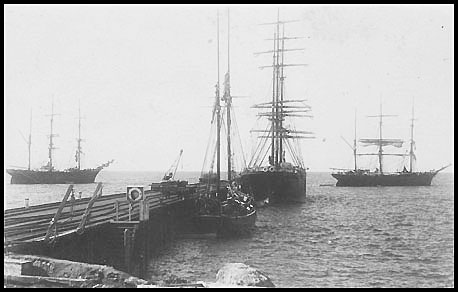The construction of telegraph line down the Yorke Peninsula.
- Site home & details
- Australia 1901-1988
- New South Wales
- Queensland
- South Australia
- Tasmania
- Victoria
- Western Australia
- International
- Special aspects
The rationale for the construction of the telegraph line down the Yorke Peninsula was based on both economic and social arguments as well as serious safety concerns for the important maritime links on which the Colony so heavily depended. Reasons underlying this latter consideration are outlined elsewhere.
- the line to Moonta;
- the line to Edithburgh & Troubridge;
- a ship wreck and some public stupidity;
- the extension of the line further south.
1. The line from Adelaide to Moonta. The lines to the Yorke Peninsula began from a point between Salisbury and Smithfield on the important 1857 line between Adelaide to Gawler. Construction began probably in the first half of 1862. The House of Assembly had approved the expenditure for the line to Kadina on 5 August 1861. The line ran to the north-west through Port Wakefield to Kadina where a Telegraph Office opened on 5 September 1862. In conveying his congratulations to the Governor, Charles Todd noted that "the interests of this important district will be greatly promoted by an immediate extension of the line to Port Wallaroo". |
 Kadina (Taylor Street) in the late 1800s. |
 |
On 21 September 1862, the House of Assembly included in the estimates "(the work for) the line of telegraph from Kadina to Wallaroo". Construction of the line to Walleroo, on the east side of the Spencer Gulf, was underway in January 1863.
This construction was partly in response to the large copper deposits at Moonta which had only been discovered in 1861. These deposits were to become the very large mine known as the Wheal Hughes mine - with other mines to follow. The Moonta mines were to become the richest in South Australia. A horse drawn tramway was built from Wallaroo to Moonta in 1863 and two years later, the telegraph line was extended to Moonta. |
In the following years, Telegraph Offices were opened along the route. Yorke Town (later Yorktown) was opened in July 1877 - a year after its change of name from Weaner's Flat chosen originally because it was the town where pastoralists separated the ewes from the lambs. Similarly Warooka, Stansbury and Minlaton were opened to serve the pastoralists and graziers in the surrounding areas.
A cable to Troubridge Lighthouse was laid in September 1882 and telegraphic communication initiated soon after.
Both Ardrossan and Port Victoria were ports from which the produce of the local area could be shipped - from Ardrosan to Adelaide and from Port Victoria to England.
3. A ship wreck and some public stupidity.
TELEGRAPHIC ANNOYANCES.The (Adelaide) Advertiser,
Thursday 4 February 1909.
"While the public of South Australia were waiting on Tuesday and Wednesday with a keen appetite for news of the great wreck off Troubridge on Sunday night, Mr. W. E. Blacker, the telegraph operator at Edithburgh, was wrestling with a big problem. The special representatives of the Adelaide press were on the scene of the disaster on Monday evening and at 10.45 p.m. had lodged the first of a long succession of heavy telegraphic messages but unfortunately the line refused duty.
The operator, who had been on duty all through Sunday night, patiently tried to get Adelaide on the wire but without success until late in the morning when he worked his messages through Maitland and Yorketown. It was all too late however for the morning papers, so residents in the country were denied the news for another day.
On Tuesday the line from Edithburgh was still working badly, and at night practically broke down again. Important telegrams detailing the evidence at the inquest were lodged before 6 p.m. and at 11 p.m. these were untouched as well as all the other messages which had accumulated since that hour. Shortly afterwards, the line became available again, but it was working so unsatisfactorily that only meagre details came through in time for the morning edition.
When the Deputy Postmaster-General (Mr. R. W. M. Waddy) was seen on Wednesday, he said he "had been apprised of and regretted the inconvenience caused. "There is only one line to Edithburgh" he added "and I think the press representatives gave the operator about 15 hours work - rather much for a single line. Added to that is the fact that there was an intermittent fault between Edithburgh and Yorketown.
Afterwards it was found that some foolish people had thrown pieces of fencing wire across the telegraph line. These bits of wire swayed to and fro against the iron pole and interrupted and delayed telegraphic work. It is a senseless thing for people to interfere with the telegraph line, especially in the country. I am sure Mr. Blacker at Edithburgh and Mr. Hopewell at Yorketown did all they possibly could to facilitate the press messages but unfortunately the line was interfered with".
Extension of the Yorke Peninsula line further south.
About the time the Overland Telegraph line was being completed, Parliament was beginning discussions on additional lines of importance to the Colony. These discussions centered on a line to Kangaroo Island and the larger issue of a line opening up Investigator Strait.
After the line had reached Warooka (1879) and Troubridge Lighthouse (1882), questions were again asked about the extension of the line to Kangaroo Island as well as to the smaller islands near Cape Spencer. One plan was to extend the line from Warooka to Cape Spencer and then by submarine cable to Althorpe Island and thence to Kangaroo Island.
The major advantage of this proposal was that Althorpe Island, where there was an operational Lighthouse, could be used to monitor shipping as it entered or left Spencer Gulf. Most of that shipping was centered on Port Augusta and Port Pirie.
Full details about the Kangaroo Island telegraph are provided elsewhere.
